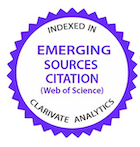Fatores de risco e sintomatologia clínica associados à infecção pelo felv: estudo caso-controle em um hospital escola veterinário
DOI:
https://doi.org/10.1590/1089-6891v20e-50797Resumo
The objective of this study was to identify risk factors and clinical features of the feline leukemia virus (FeLV) infection in domestic cats (Felis catus) seen at a Veterinary Teaching Hospital. A case-control study was performed to determine the risk factors and a descriptive study was done to define the clinical symptoms of the sick animals. From January 2013 to January 2014, 175 medical records of cats seen at the hospital were evaluated. FeLV was found in 34 of them (19.4%). It was noticed an association between age and the FeLV infection (p=0,009); higher incidence of the infection occurring in animals between one and four years old. Hematopoietic neoplasias (p=0,000022), anemia (p<0,0000001), leukopenia (p=0,04) and hyperproteinemia (p=0,043) were associated with FeLV infection. Unspecific symptoms were observed in 51.8% of the animals. Clinical signs associated with respiratory, digestive, tegumentary and nervous systems were present in 20.6%, 14.7%, 5.9% and 5.9% respectively. This study concluded that age between one and four years old is a risk factor for FeLV infection. On the other hand, sex and outdoor access are not risk factors for the infection. FeLV infection is associated with anemia, leucopenia, hematopoietic neoplasia and hyperproteinemia.
Keywords: Epidemiology, Feline leukemia virus, infectious diseases, retrovirus.
Downloads
Publicado
Como Citar
Edição
Seção
Licença
Copyright (c) 2019 Ciência Animal Brasileira

Este trabalho está licenciado sob uma licença Creative Commons Attribution 4.0 International License.
Autores que publicam nesta revista concordam com os seguintes termos:
- Autores mantém os direitos autorais e concedem à revista o direito de primeira publicação, com o trabalho simultaneamente licenciado sob a Licença Creative Commons Attribution que permite o compartilhamento do trabalho com reconhecimento da autoria e publicação inicial nesta revista.
- Autores têm autorização para assumir contratos adicionais separadamente, para distribuição não-exclusiva da versão do trabalho publicada nesta revista (ex.: publicar em repositório institucional ou como capítulo de livro), com reconhecimento de autoria e publicação inicial nesta revista.
- Autores têm permissão e são estimulados a publicar e distribuir seu trabalho online (ex.: em repositórios institucionais ou na sua página pessoal) a qualquer ponto antes ou durante o processo editorial, já que isso pode gerar alterações produtivas, bem como aumentar o impacto e a citação do trabalho publicado (Veja O Efeito do Acesso Livre).






























